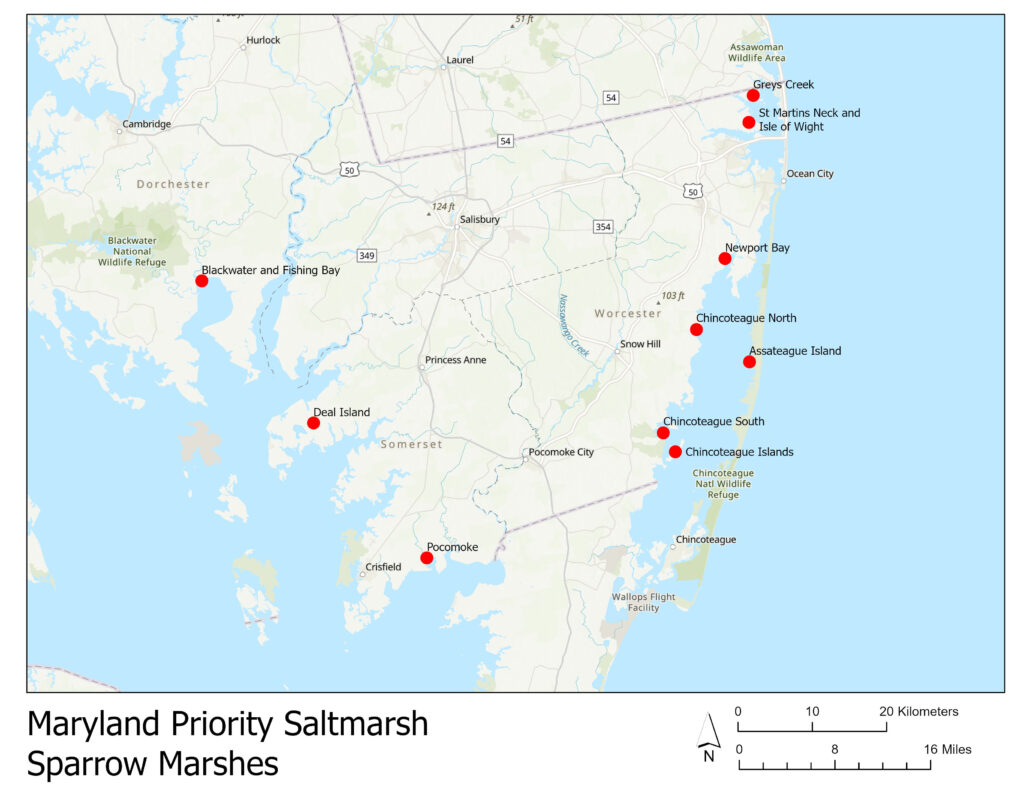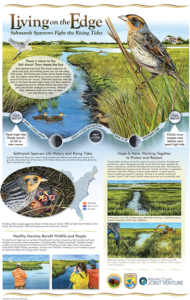Supporting Regional Surveys

Saltmarsh Sparrow Survey. Photo by Lauren Owens Lambert
In 2021, the Saltmarsh Habitat and Avian Research Program (SHARP) with partners were able to cover roughly 60% of historical survey points surveyed in 2011/2012. The ACJV is now coordinating with partners in each state to help boost effort for the second year of surveys in 2022. The USFWS has also allocated $110k in USFWS funds to support the surveys directly. Given a robust field effort in 2022, these data can then be analyzed to update population estimates and create spatially explicit trends and trend estimates to help understand where the Saltmarsh Sparrow is in decline and where it is not. This information, along with the occupancy and density estimates (mentioned above) can inform local planning for marsh restoration and protection.
Guiding Local Saltmarsh Sparrow Conservation

Priority salt marshes in Maryland
One of the most common requests we hear from partners is to provide them with a list of priority marshes and management actions for their area so that they can determine the best places to work and allocate resources. In response, we have spent the last year working with groups of partners within each state to outline priority marshes for conservation and restoration that will best support the Saltmarsh Sparrow. We have used a combination of the Saltmarsh Sparrow Habitat Prioritization Tool (an interactive mapping tool created last year by the ACJV), state-level data, and expert input to identify marshes for inclusion in the priority list. Partners then developed a list of suggested management and restoration actions to explore for each marsh. A complete set of state-level documents will be finalized by February, 2022. Our goal is to then use this information to inform an interactive online mapping tool in 2022 to highlight priority marshes for conservation and restoration within the breeding range of the Saltmarsh Sparrow.
Addressing Permitting Hurdles
Restoration involves more than just design and construction. As those working on the ground know well, each project must also satisfy an array of permitting criteria designed to protect wetlands and wildlife. Although these permits are designed to prevent harm, the modern threat of sea level rise and the need to rapidly apply innovative practices across large scales to build marsh resiliency, have changed the game. Conservation project needs are now often at odds with permitting requirements and the permitting process itself has become a barrier to implementation in some places. Permitting for salt marsh restoration projects can delay a project for months or even years! In a pilot effort to address this major challenge, the ACJV has partnered with State, Federal and NGO partners in Massachusetts to design an approach to streamline the State permitting process. This group identified 10 laws or policies that restoration projects must comply with and 29 barriers to implementation that are greatly slowing our ability to achieve resiliency. A series of solutions to address these barriers was then developed and prioritized. Meetings are currently underway at the Secretary level with the goal of identifying ways to streamline and improve the efficiency of the permitting process for habitat restoration work.
Beneficial Use of Sediments for Marsh Conservation

Applying dredge sediment to a New Jersey salt marsh. TNC
The New Jersey – Delaware Tidal Marsh Working Group has been focusing its efforts on building a shared understanding about the “beneficial use” of dredged sediments as a salt marsh restoration technique. Dredging, and dredged sediment, is more widespread/available in New Jersey than in much of the ACJV area and there is a strong interest in ensuring that these sediments be used to provide ecological uplift to coastal habitats. With support from the NJ-DE Tidal Marsh Working Group steering committee, The Nature Conservancy and ACJV staff developed and implemented three practitioner work sessions in April and May, 2021 on this topic. These sessions, which engaged over 70 participants primarily from the Mid-Atlantic region, identified several key themes and an initial synthesis of the state of the practice. The Beneficial Use Learning Network was formally launched in October to provide an ongoing series of webinars and workshops to engage a broad group of stakeholders who want to understand and implement beneficial use projects and to provide a forum for intentional learning exchange. The network is organized by a multi-organizational committee, led by The Nature Conservancy (TNC) with support from the ACJV and USFWS Coastal Program.
An anticipated outcome of this effort in early 2022 is a series of learning resources documenting the lessons learned and other information shared through learning network workshops and webinars. The goal is to reflect the state of the practice of beneficial use as advances are made through learning and on-the-ground projects.
Improved Coordination with NOAA
Staff from the National Oceanic and Atmospheric Administration (NOAA), ACJV, and several other USFWS programs have formed an informal team to improve coordination and collaboration between NOAA, USFWS, and our partners. NOAA, through its National Marine Fisheries Service (NMFS), plays a regulatory advisory role in most potential salt marsh restoration projects, under the Magnuson-Stevens Act. Because of that Act, which regulates Essential Fish Habitat (EFH), NOAA/NMFS emphasize the conservation of low marsh, mud flats, and open water as EFH. That creates the potential for conflict if partners want to implement restoration projects that primarily benefit high marsh habitat, which isn’t considered EFH. Our small working group is developing a white paper for the Northeast region to encourage and facilitate salt marsh restoration projects that benefit the full complement of tidal marsh habitats and ecosystem services. By encouraging all our partners to consider how their projects could be designed to provide ecological benefits (and avoid detrimental impacts) to a broader suite of taxa, including those dependent on high and low marsh, we hope to ultimately effect more and larger projects over time.
Saltmarsh Sparrow Poster

Saltmarsh Sparrow Poster
The Saltmarsh Sparrow Living on the Edge poster tells the tale of a little brown bird living in a sea of green grass. The purpose of the poster is to raise awareness of a bird that most people don’t see or know anything about; to foster an appreciation of a habitat that is greatly taken for granted; and to show the efforts of partners to restore and protect the bird and habitat that is intrinsically important in our lives.
At first blush, neither bird nor habitat are very exciting. But look a little closer and you see a sturdy sparrow fighting for its life – through climate driven rising tides and loss of habitat from past and present changes to the marsh. This bird’s life is interconnected with moon cycles and tides and it needs the perfect conditions of grass and elevation to build a nest and successfully raise young. While it’s important to protect and restore this habitat for the sake of the Saltmarsh Sparrow, the ties that humans have to coastal marshes can not be overstated. These habitats protect our homes from storms; provide communities with clean water; and support recreation and tourism opportunities to communities.
The poster is available for anyone to use in their outreach efforts. Contact debra_reynolds@fws.gov
